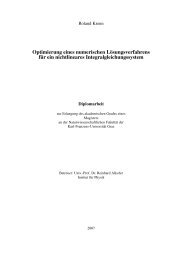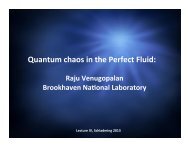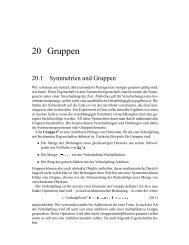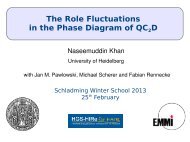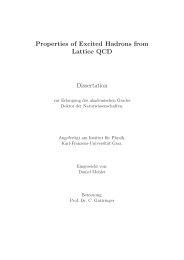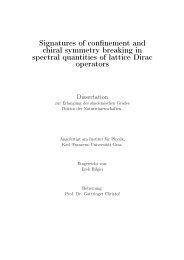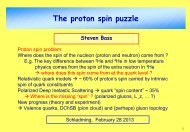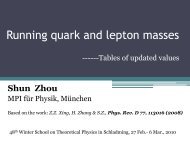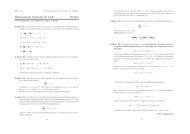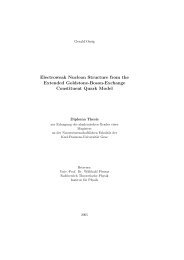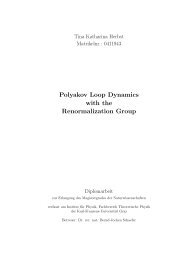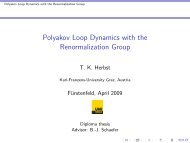The QCD Quark Propagator in Coulomb Gauge and - Institut für Physik
The QCD Quark Propagator in Coulomb Gauge and - Institut für Physik
The QCD Quark Propagator in Coulomb Gauge and - Institut für Physik
Create successful ePaper yourself
Turn your PDF publications into a flip-book with our unique Google optimized e-Paper software.
Chapter 6. Nucleon Form Factors <strong>in</strong> a Covariant Diquark-<strong>Quark</strong> model 81<br />
Table 6.4: Magnetic moments, <strong>in</strong> nuclear magnetons, calculated with the diquark mass-scales<br />
<strong>in</strong> table 6.1 <strong>and</strong> the parameter range described <strong>in</strong> table 6.2, cf. [AHK + 05]. Columns labelled<br />
σ give the percentage-difference from results obta<strong>in</strong>ed with the reference values: µ 1 + = 2,<br />
χ 1 + = 1, κ T = 2. Experimental values are: κ p := µ p − 1 = 1.79 <strong>and</strong> µ n = −1.91.<br />
set A<br />
set B<br />
µ 1 + χ 1 + κ T κ p σκ A p<br />
|µ n | σ|µ A n|<br />
κ p σκ B p<br />
|µ n | σ|µ B n|<br />
1 1 2 1.79 -15.3 1.70 -5.1 2.24 -21.9 2.00 -6.2<br />
2 1 2 2.06 1.79 2.63 2.13<br />
3 1 2 2.33 15.4 1.88 5.1 3.02 21.9 2.26 6.1<br />
2 0 2 2.06 0.0 1.79 0.0 2.63 0.0 2.13 0.0<br />
2 2 2 2.06 0.0 1.79 0.0 2.63 0.0 2.13 0.0<br />
2 1 1 1.91 -8.4 1.64 -8.4 2.45 -10.1 1.95 -8.5<br />
2 1 3 2.21 8.4 1.85 8.3 2.82 10.1 2.31 8.5<br />
greatest sensitivity to the axial-vector diquarks’s electromagnetic properties but <strong>in</strong> this<br />
case, too, the differences between set A <strong>and</strong> set B are more significant. For Q 2 4 GeV 2<br />
there is no sensitivity to the diquarks’ electromagnetic parameters <strong>in</strong> any curve. This is<br />
naturally because our parametrisation expresses the perturbative limit, equation(6.78).<br />
It is thus apparent from these figures that the behaviour of the nucleons’ form factors is<br />
primarily determ<strong>in</strong>ed by the <strong>in</strong>formation encoded <strong>in</strong> the Faddeev amplitudes.<br />
Our results show that the nucleons’ electromagnetic properties are sensitive to the<br />
strength of axial-vector diquark correlations <strong>in</strong> the bound state <strong>and</strong> react to the electromagnetic<br />
properties of these correlations. In all cases the dependence is readily understood<br />
<strong>in</strong>tuitively. However, taken together our results <strong>in</strong>dicate that one cannot readily tune the<br />
model’s parameters to provide a uniformly good account of nucleon properties: someth<strong>in</strong>g<br />
more than dressed-quark <strong>and</strong> -diquark degrees of freedom is required.<br />
Chiral corrections<br />
It is appropriate now to exam<strong>in</strong>e effects that arise through coupl<strong>in</strong>g to pseudoscalar<br />
mesons. As with baryon masses, there are two types of contributions from meson loops to<br />
electromagnetic form factors: regularisation-scheme-dependent terms, which are analytic<br />
<strong>in</strong> the neighbourhood of ˆm = 0, <strong>and</strong> nonanalytic scheme-<strong>in</strong>dependent terms. For the static<br />
properties presented <strong>in</strong> tables 6.2–6.4, the lead<strong>in</strong>g-order scheme-<strong>in</strong>dependent contributions



